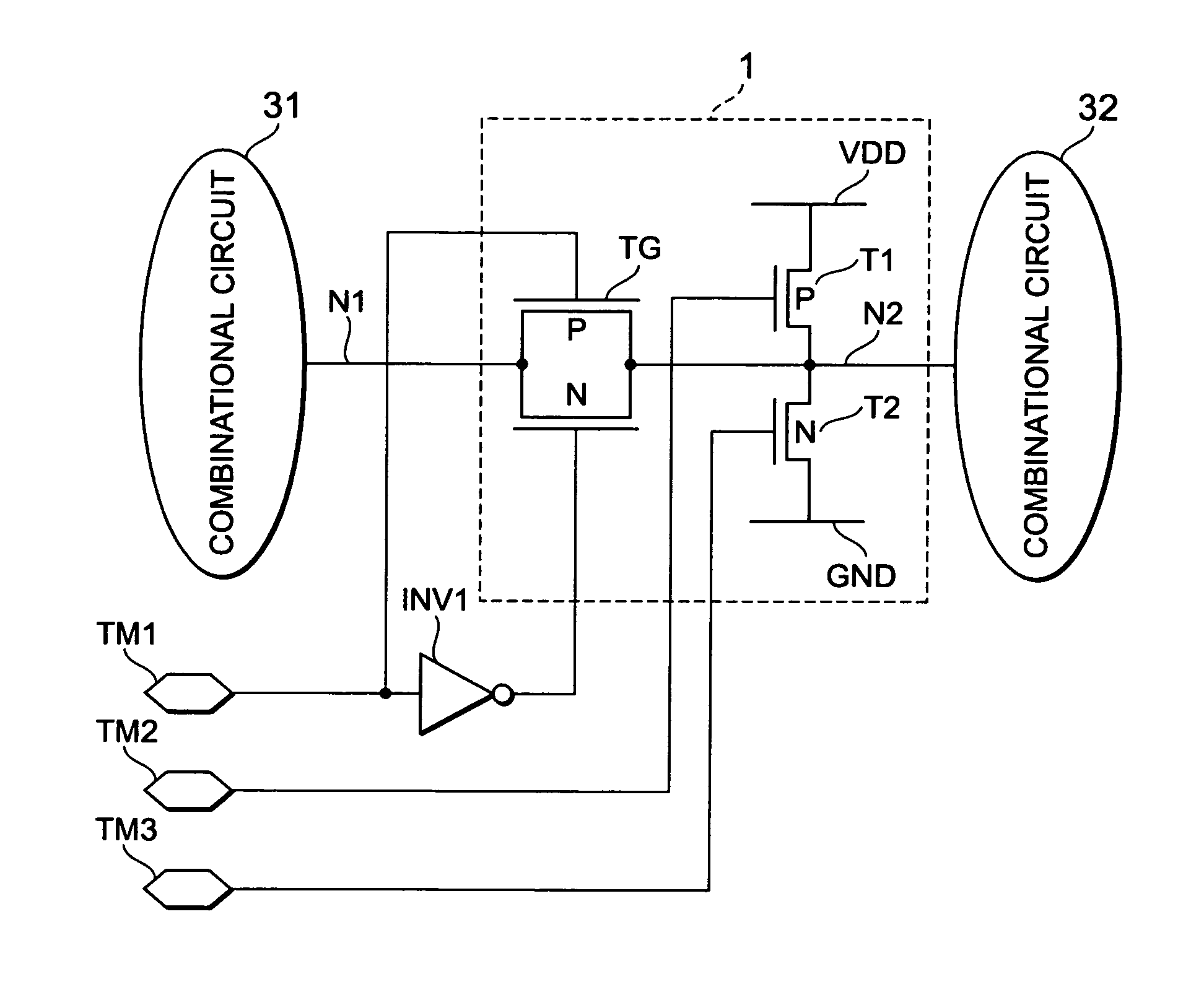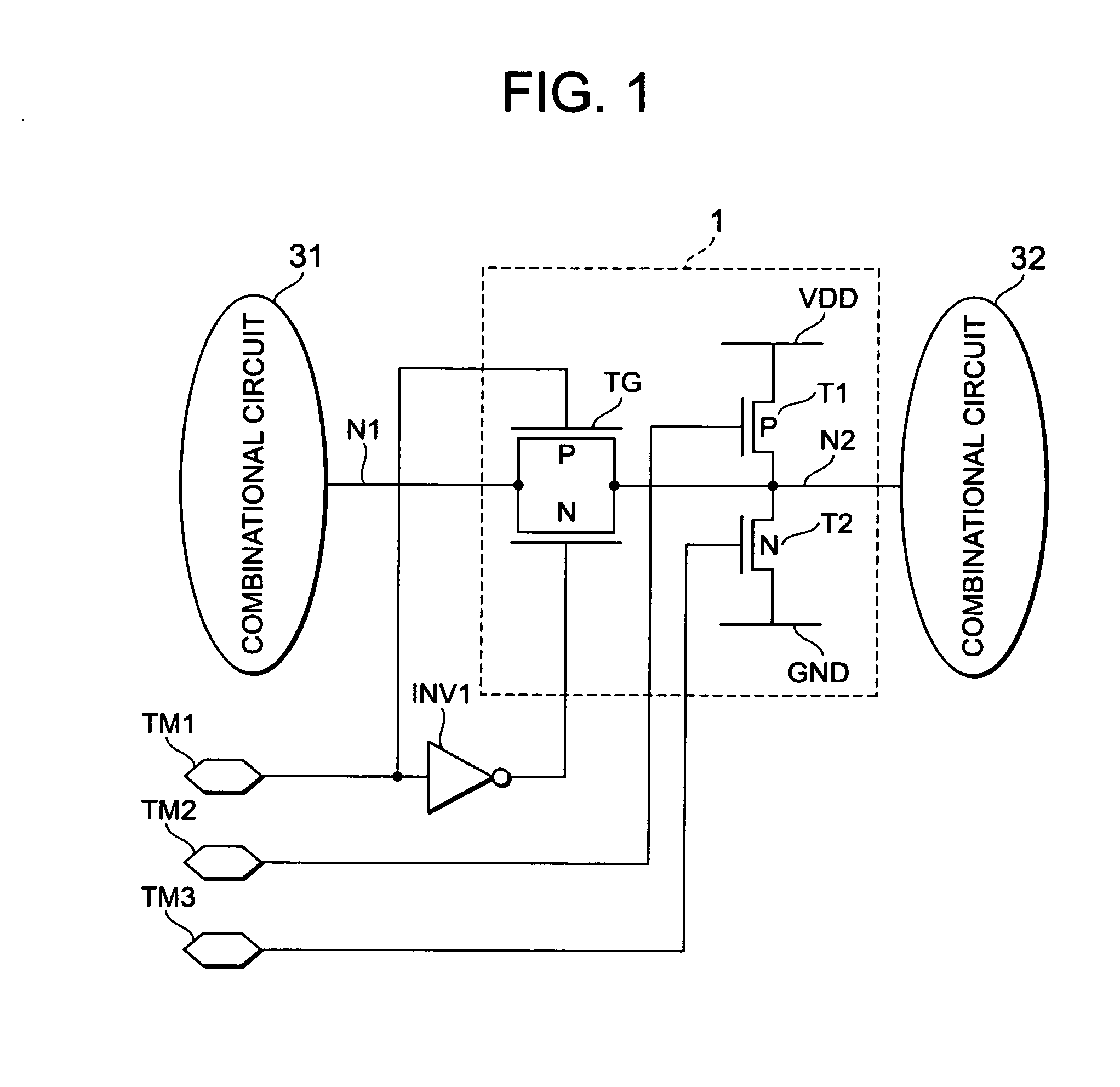Semiconductor device test circuit, semiconductor device, and its manufacturing method
a semiconductor device and test circuit technology, applied in the field of test circuits, can solve the problems of insufficient inability to fix the potential level in each of the internal nodes, and insufficient toggling the output of such a f/f circuit that cannot be included in a scan chain, so as to suppress the overhead of the semiconductor circuit and the effect of the semiconductor circuit overhead
- Summary
- Abstract
- Description
- Claims
- Application Information
AI Technical Summary
Benefits of technology
Problems solved by technology
Method used
Image
Examples
first embodiment
[0037]At first, there will be described a configuration of a test circuit 1, as well as configurations of its peripheral circuits in the first embodiment of the present invention with reference to the block diagram shown in FIG. 1. The test circuit 1 includes a transfer gate switch TG consisting of a PMOS (Positive-channel Metal Oxide Semiconductor) transistor and an NMOS (Negative-channel Metal Oxide Semiconductor) transistor. The test circuit 1 also includes a first transistor (PMOS) T1 connected between a power supply VDD and a node N2 and a second transistor (NMOS) T2 connected between a ground GND and the node N2.
[0038]The node N1 connected to a combinational circuit 31 and the node 2 connected to another combinational circuit 32 are connected to each other through the transfer gate switch TG. A test mode control terminal TM1 is connected to the PMOS transistor of the transfer gate switch TG so as to have a positive logic and to the NMOS transistor so as to have an inverted log...
second embodiment
[0050]Next, there will be described a configuration of a test circuit 1 and configurations of its peripheral circuits in this second embodiment with reference to the block diagram shown in FIG. 3. The test circuit 1 is the same in configuration as that shown in FIG. 1, so that its description will be omitted here.
[0051]A node N1 connected to a combinational circuit 31 and another node N2 connected to another combinational circuit 32 are connected to each other through a transfer gate switch TG. A test mode control terminal TM1 is connected to a PMOS transistor of the transfer gate switch TG and a test decoder TD so as to have a positive logic respectively while the test mode control terminal TM1 is connected to an NMOS transistor of the transfer gate switch TG so as to have an inverted logic generated by an inverter logic block INV1. The test mode control terminal TM2 is connected to the test decoder TD. The test decoder TD is connected to the first transistor T1 through a test deco...
third embodiment
[0066]In this third embodiment of the present invention, the test mode control terminal TM2 used in the second embodiment is replaced with a scan clock terminal CLK.
[0067]At first, there will be described a configuration of a test circuit 1 and configuration of its peripheral circuits with reference to the block diagram shown in FIG. 7. In FIG. 7, the test mode control terminal TM2 shown in FIG. 3 is replaced with a scan clock terminal CLK as described above. Other components are the same as those shown in FIG. 3, so that the description for them will be omitted here.
[0068]Also in the test decoder TD shown in FIG. 8, the test mode control terminal TM2 shown in FIG. 4 is replaced with a scan clock terminal CLK. Other parts are the same as those shown in FIG. 4, so that the description for them will be omitted here.
[0069]Next, there will be described a configuration of a test circuit 1 that includes a built-in test circuit 1 with reference to the clock diagram shown in FIG. 10. In the...
PUM
 Login to View More
Login to View More Abstract
Description
Claims
Application Information
 Login to View More
Login to View More - R&D
- Intellectual Property
- Life Sciences
- Materials
- Tech Scout
- Unparalleled Data Quality
- Higher Quality Content
- 60% Fewer Hallucinations
Browse by: Latest US Patents, China's latest patents, Technical Efficacy Thesaurus, Application Domain, Technology Topic, Popular Technical Reports.
© 2025 PatSnap. All rights reserved.Legal|Privacy policy|Modern Slavery Act Transparency Statement|Sitemap|About US| Contact US: help@patsnap.com



